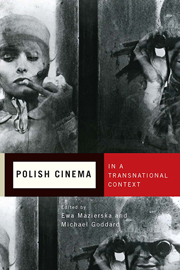Book contents
- Frontmatter
- Contents
- Acknowledgments
- Introduction: Polish Cinema beyond Polish Borders
- Part One The International Reception of Polish Films
- Part Two Polish International Coproductions and Presence in Foreign Films
- Part Three Émigré and Subversive Polish Directors
- 11 An Island Near the Left Bank: Walerian Borowczyk as a French Left Bank Filmmaker
- 12 Beyond Polish Moral Realism: The Subversive Cinema of Andrzej Żuławski
- 13 Polanski and Skolimowski in Swinging London
- 14 The Elusive Trap of Freedom?: Krzysztof Zanussi's International Coproductions
- 15 Agnieszka Holland's Transnational Nomadism
- Selected Bibliography
- List of Contributors
- Index
13 - Polanski and Skolimowski in Swinging London
from Part Three - Émigré and Subversive Polish Directors
Published online by Cambridge University Press: 05 April 2014
- Frontmatter
- Contents
- Acknowledgments
- Introduction: Polish Cinema beyond Polish Borders
- Part One The International Reception of Polish Films
- Part Two Polish International Coproductions and Presence in Foreign Films
- Part Three Émigré and Subversive Polish Directors
- 11 An Island Near the Left Bank: Walerian Borowczyk as a French Left Bank Filmmaker
- 12 Beyond Polish Moral Realism: The Subversive Cinema of Andrzej Żuławski
- 13 Polanski and Skolimowski in Swinging London
- 14 The Elusive Trap of Freedom?: Krzysztof Zanussi's International Coproductions
- 15 Agnieszka Holland's Transnational Nomadism
- Selected Bibliography
- List of Contributors
- Index
Summary
Roman Polanski's Repulsion (1965) and Jerzy Skolimowski's Deep End (1971), very different though they are in style and subject matter, both set their stories in a London that is an odd combination of the familiar and the alien. Both films explore the effect of a sexual revolution that has dredged up unexpected anxieties and dangers for young people entering into a world where—as Mick Jagger puts it in Performance (1971), “Nothing is true, everything is permitted.” One might expect Polanski and Skolimowski, refugees from the gray wastelands behind the Iron Curtain, to revel in the pleasures of colorful, liberated London. Instead, they retain an outsider's skeptical pessimism, and thus are able to reveal a society driven by guilt, insecurity, prejudice, and sexual uncertainty. This chapter will analyze how and why Repulsion and Deep End are able to offer such resonant and convincing representations of life in Sixties Britain.
Polanski came to London in 1964, when “Swinging London” was still a secret shared by a small elite of musicians, artists, fashion designers, photographers, and media personalities. Its manifestation in films was hinted at in zany satires like Nothing but the Best (Clive Donner, 1964), but it was not until John Schlesinger's Darling, released in mid-1965, that it was to become a recognized phenomenon. Polanski made Repulsion to fit the vogue for psychological horror films as a way of securing funding for more personal projects, but he cleverly uses London locations and the climate of sexual permissiveness to add depth and resonance to his tale of repression and madness. Skolimowski did not arrive in England until the end of the decade, by which time the United Kingdom's economic problems had tarnished the bright hopes of a prosperous, classless society and permissiveness had degenerated into sleaze and exploitation.
- Type
- Chapter
- Information
- Polish Cinema in a Transnational Context , pp. 258 - 274Publisher: Boydell & BrewerPrint publication year: 2014

